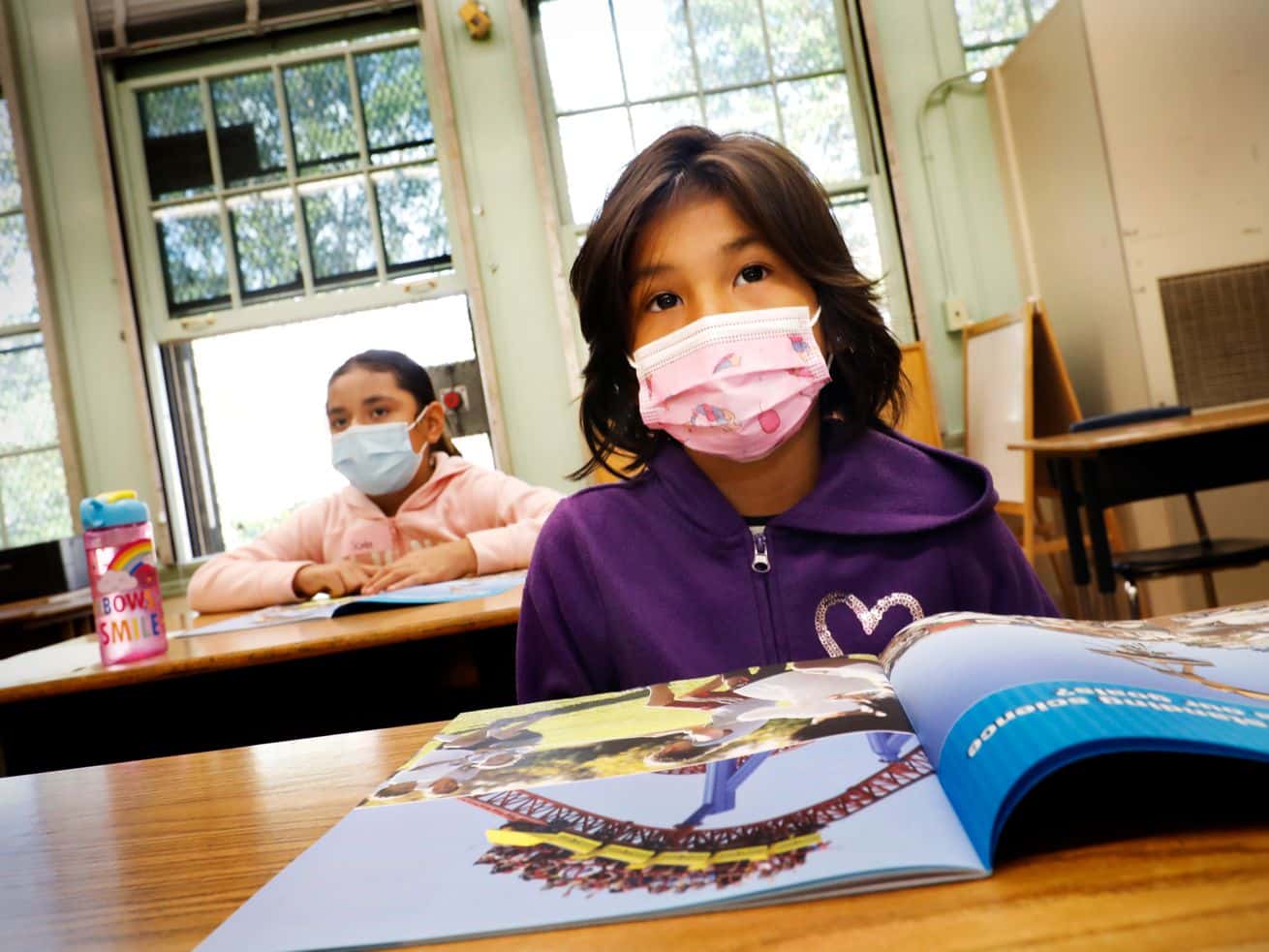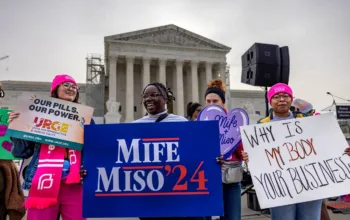The CDC says some schools can drop mask mandates — but not all of them.
As the US quickly returns to a pre-pandemic normal, the Centers for Disease Control and Prevention is now working to ensure that schools do the same — releasing new guidelines last week outlining, in part, when schools should still consider mandating masks.
The guidelines put the CDC at the center of yet another Covid-19 controversy. As everything from concerts to bars to movie theaters has started up again, parents have pushed for schools to pull back Covid-related restrictions, too, leading to protests and shouting over masks at public school board meetings. Elected officials have taken note, with eight states now banning school districts from imposing mask mandates.
But experts say there are good reasons to continue requiring masks in at least some schools, particularly those where the majority of the student body isn’t — or can’t be — vaccinated and in areas where the coronavirus is still spreading at high rates. The CDC guidelines reflect this expert guidance, arguing that universal masking requirements make sense in several circumstances.
One key consideration: Children under 12 can’t yet get the vaccines. Since the CDC still recommends that unvaccinated people wear masks, it follows that kids under 12 should wear masks in schools — and those around them should as well to mitigate the risks of Covid-19 spread to potentially vulnerable children as much as possible.
“The people who are at risk are those who are unvaccinated,” Katherine Auger, a health policy researcher at Cincinnati Children’s Hospital, told me. “And we know all kids under 12 are unvaccinated at this point.”
For experts, it’s about a cost-benefit analysis. It’s true, they acknowledge, that children generally face a much lower risk from Covid-19 than older populations. But, at the same time, masks also are a very low-cost intervention: They are cheap, aren’t more than a minor hassle to wear, and can do a lot to stop the wearer from catching or spreading Covid-19. In short, masks are a low-cost, high-benefit intervention — one that can help ensure the defeat of Covid-19 this fall, before all kids get vaccinated, so high-cost interventions aren’t needed again. It’s about transitioning from Zoom school to a pre-pandemic normal responsibly, ensuring that the coronavirus isn’t given a chance to surge back and trump progress so far.
Part of the consideration here is the risk to kids of Covid-19, while low, isn’t zero. More than 300 children (under 18) have died of Covid-19 in the US, and that’s with widespread social distancing and masking keeping deaths down for much of the past year and a half. There are also concerns about Covid-19’s long-term consequences — with the evidence so far suggesting, Brown University School of Public Health dean Ashish Jha told me, “that it’s not great to have contracted Covid.”
Experts also worry that kids could spread Covid-19 to people who are more vulnerable, or keep the virus circulating in a way that might allow it to mutate into yet another variant of concern.
The good news is the vaccines work. So high schools with teenagers, who are now eligible to get vaccinated, can ditch the masks if their students are vaccinated. Once children under 12 are eligible for the shot (perhaps in the coming fall or winter), elementary and middle schools could follow as well. The CDC guidelines are explicit in differentiating older and younger student bodies for this reason.
Ultimately, there will be variation in how schools interpret all of this. Different places will be at different stages with Covid-19, based on their case counts and vaccination rates. Different communities will have different levels of risk tolerance, with some favoring a higher degree of risk to move closer to a pre-pandemic normal. Schools that serve more students who are immunocompromised or are otherwise at serious risk of Covid-19 may lean on the safe side. Even individual parents will likely make different decisions for their children.
But to make all of this advice more actionable, I talked to experts about what schools and parents should watch out for when considering masking up. That led to the following three rules on when schools should mandate or at least encourage covering up those faces.
1) If Covid-19 is still quickly spreading in the community, mask
If the community around a school is still seeing a lot of Covid-19 spread, the school is at risk, too: The more the virus is spreading, the more likely it is to end up in a school building and cause a local outbreak. One study published by the National Bureau of Economic Research found places that reopened schools despite high levels of Covid-19 saw accelerated spread.
As the CDC notes, schools may want to require masking if they see “increasing or substantial or high COVID-19 transmission within the school or their surrounding community.”
A good benchmark here is dropping, and staying, below four daily new cases per 100,000 people. That’s roughly in line with White House adviser Anthony Fauci’s recommendation that the US needs to, as a whole, get below 10,000 daily new cases to get the virus under control.
To make sure they’re in the clear, school districts should look at local data, at either the county or city level. They can also check that data with testing positivity rates — which should be below 5 percent if there’s enough testing — and state figures to make sure there might not be a hidden outbreak or one around the corner.
And if Covid-19 cases do start popping up in a school, officials should be ready to respond with escalated measures, from masking to physical distancing to a hybrid model, to prevent an outbreak from spiraling out of control.
“Have some situational awareness,” Meagan Fitzpatrick, an infectious disease modeler at the University of Maryland, told me. “Look at what’s happening with Covid in your community. And have a plan that’s responsive — that doesn’t just make one blanket statement, yes or no, about masks but has a responsive attitude about it.”
2) If vaccination rates are still low in the community, mask
Even if a community sees low numbers of Covid-19 cases, there’s another number they should look at to feel in the clear: vaccination rates. Because if a community or school isn’t sufficiently vaccinated, it remains at risk of the coronavirus coming back — all it takes is one infected person interacting with others to potentially launch an epidemic.
In general, higher vaccine rates are always good — there’s no upper limit. But the evidence from different states and other countries indicates that around 60 percent vaccination rate is when cases really start to drop and stay low.
There’s also evidence that places with low vaccination rates are more likely to see Covid-19 outbreaks. A New York Times analysis found that places with 60-plus percent of their population vaccinated report about a third of the cases as those with 0 to 30 percent vaccination rates.
School districts, then, should generally aim for at least 60 percent vaccination rates, looking particularly at these rates among their staff and student bodies. They can also look at community vaccination rates — since, again, risk out in the community can lead to risk in the school.
For elementary and middle schools, that likely means, the CDC suggests, they won’t be able to drop universal mask mandates this fall since their student bodies won’t be eligible for the shots. For high schools, this means they can drop the mask mandates — as long as enough of their staff and students are vaccinated.
To ensure this happens quicker, schools should also consider mandating the vaccine, as they do with vaccines for other diseases. Schools could also try the carrot instead of the stick: They could suggest that people can ditch the mask if they’re vaccinated, or make it explicit that the school district will drop a mask mandate once it reaches a certain rate of vaccination among its students and staff.
But if a school does reach high vaccination rates along with low case counts, it can feel safe in dropping a mask mandate and other restrictions around Covid-19.
3) When in doubt, mask
Over the past year and a half, people have made a lot of sacrifices to combat Covid-19. Workplaces shut down. Schools closed. Places of socialization and entertainment vanished. All of this happened so quickly that it felt like our lives were upended overnight.
Masks, in comparison, were a relatively small intervention. Yes, they can be a bit of a hassle, and in some situations, including the classroom, they can make it harder to read faces.
But those are minor costs for stopping a deadly pathogen, especially when compared to the costs, financial or otherwise, of social distancing, mass testing, and better ventilation in buildings.
This is something that experts emphasized to me time and again: Once you look past the broader symbol that masks have become, they are a very low-cost intervention that, in the middle of a pandemic, can lead to big benefits.
“Most kids don’t care that much” about having to wear a mask, Jha said. “It’s not that big of a deal.”
In that context, maybe we shouldn’t make too much out of requiring masks in schools. It might be a good idea to play it safe, given the low cost of doing so.
That’s especially true if masks are, short of broader vaccination, the thing that prevent a community from having to deploy much more costly, much more intrusive interventions. If masking prevents a Covid-19 outbreak that otherwise would have shut down a school or at least forced it to go back to a hybrid model, then universal masking is obviously the winner.
“What are the simple things, low-cost things we can do to keep people in the classroom?” Auger said. “Something like a mask doesn’t prevent normal interaction. It doesn’t prevent learning. It is a low-cost, low-risk intervention that actually has a decent return on value.”
Looming over all of this is the risk of new Covid-19 variants. Some experts said that the delta variant has already made them more cautious about the future. While the vaccines seem to work against the variants so far, they can still hit unvaccinated people hard — as Israel recently saw with outbreaks in schools with low vaccination rates.
It’s not just delta. The CDC warned of a worse possibility, in which a variant pops up “that is spread more easily among children and adolescents or is resulting in more severe illness from COVID-19 among children and adolescents.” That would dramatically shift the cost-benefit analysis of masks and other precautions in schools, since Covid-19 would suddenly be a much bigger threat to children.
The best way to prevent the emergence of new variants is to shrink the spread of Covid-19 altogether — to rob the virus of more opportunities to replicate, mutate, and transmit. That means vaccinating as many people as possible, but, also, when vaccination is not possible, following the standard precautions, including masks. Schools can play a role here, too.
The upshot is even schools that feel safe from Covid-19 right now should remain ready to adapt along with the virus. And when there’s any doubt, turn to the mask — which still, at the end of the day, comes at a fairly low cost.
Author: German Lopez
Read More



